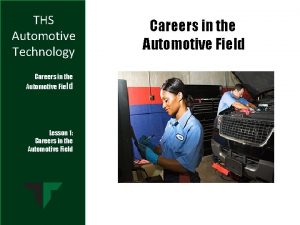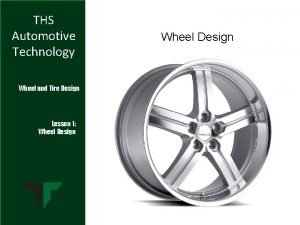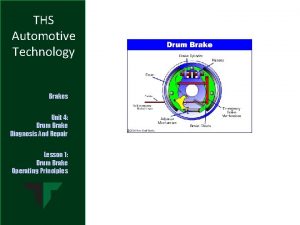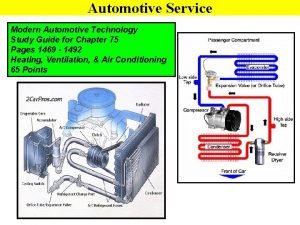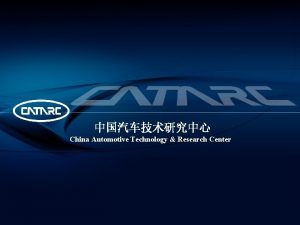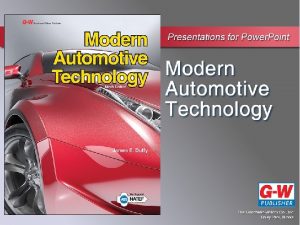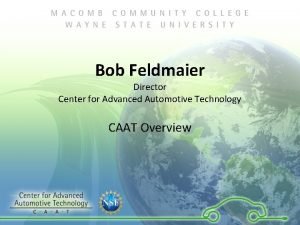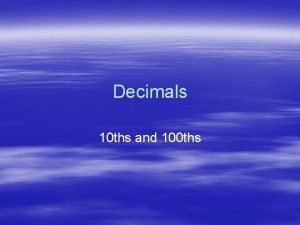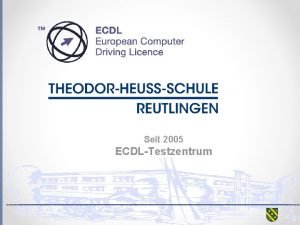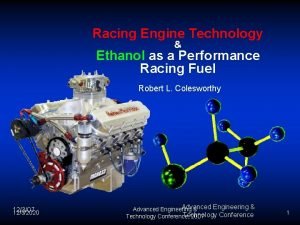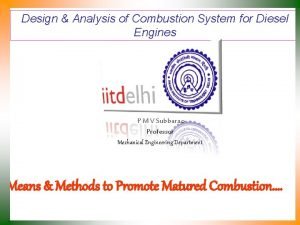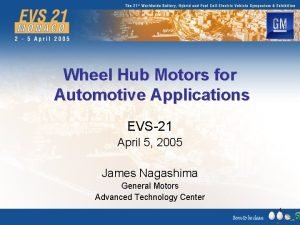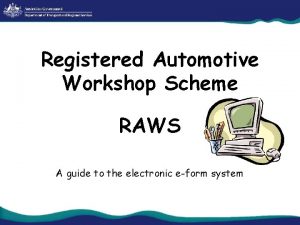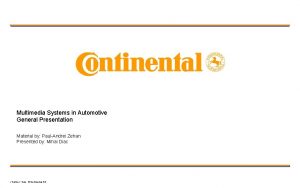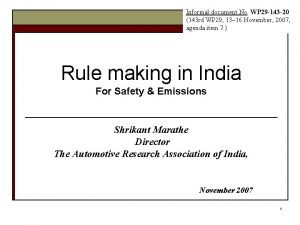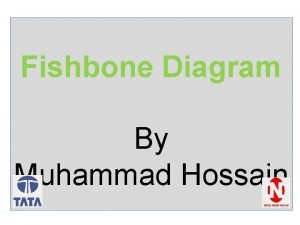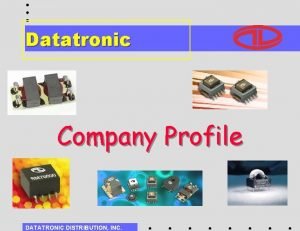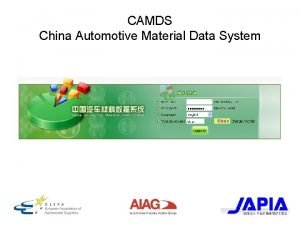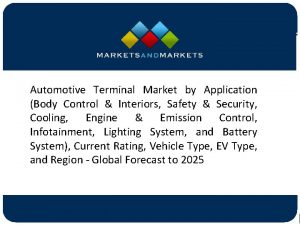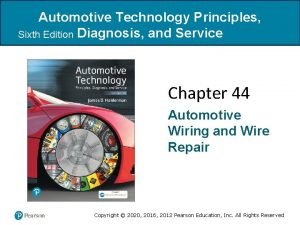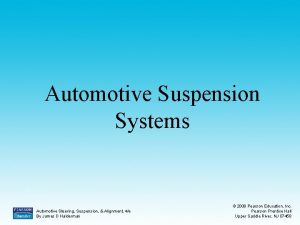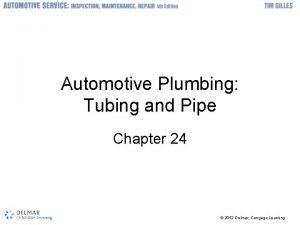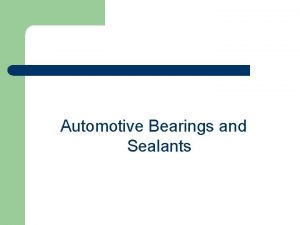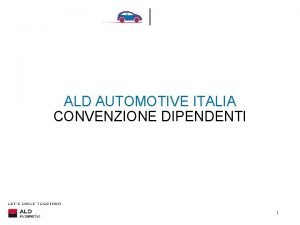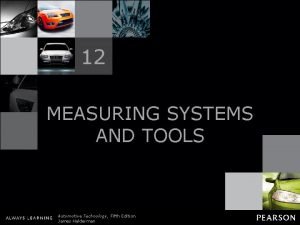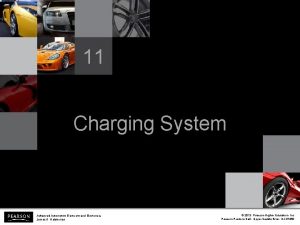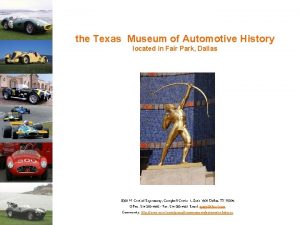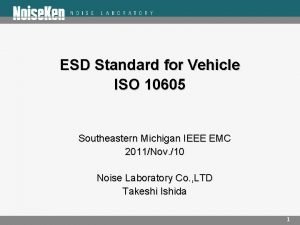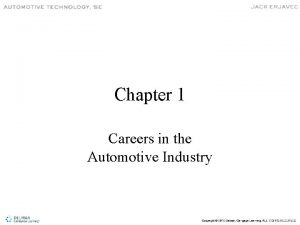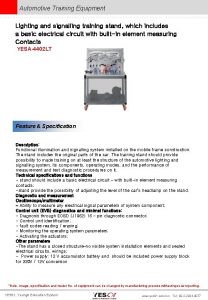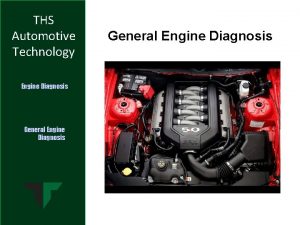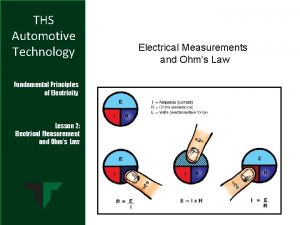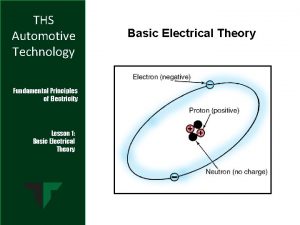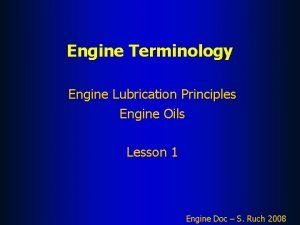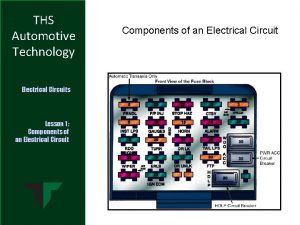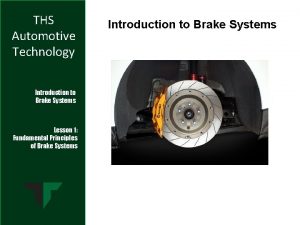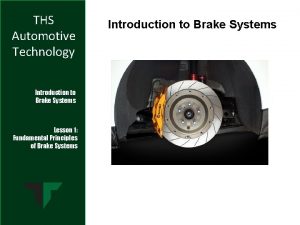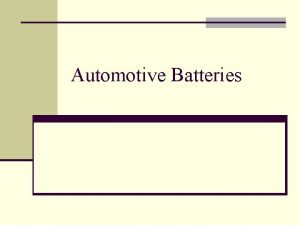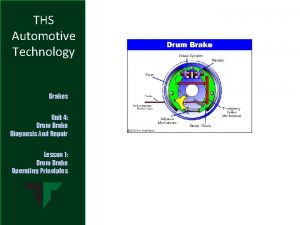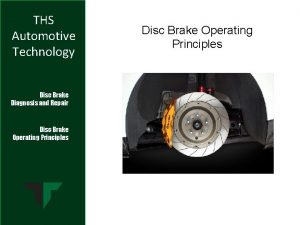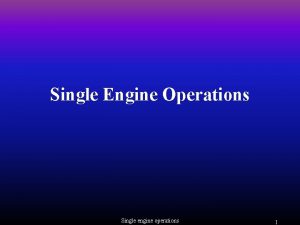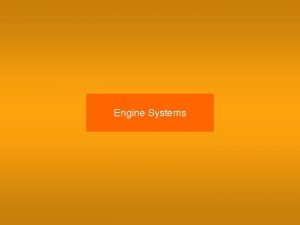THS Automotive Technology Engine Design Lesson 1 Principles















































- Slides: 47

THS Automotive Technology Engine Design Lesson 1: Principles of Engine Design

THS Automotive Technology Engine Design Lesson 1: Principles of Engine Design Components of a typical internal combustion engine • The short block includes the following components: cylinder block, crankshaft, piston and rod assembly, and sometimes the camshaft and timing set (non-overhead camshaft engines). The cylinder block, which is the foundation for the short block, is made from cast iron or cast aluminum. The cylinder block is usually cast in one piece. • The block contains the bearings that support the crankshaft and the cylinders within which the pistons move.

THS Automotive Technology Engine Design Lesson 1: Principles of Engine Design Components of a typical internal combustion engine • In liquid-cooled engines, the block contains the water jacket.

THS Automotive Technology Engine Design Lesson 1: Principles of Engine Design Components of a typical internal combustion engine The crankshaft converts the reciprocating (up-and-down) motion of the pistons and rods into rotating motion. • The crankshaft is located at the bottom or center of the short block. Because it is mounted in bearings, the crankshaft can rotate freely within the short block.

THS Automotive Technology Engine Design Lesson 1: Principles of Engine Design Components of a typical internal combustion engine • The crankshaft is also connected to the piston and rod assembly with bearings. The bearings allow each connecting rod to rotate freely on the crankshaft as it turns.

THS Automotive Technology Engine Design Lesson 1: Principles of Engine Design Components of a typical internal combustion engine Piston and rod assembly • The piston and rod assembly absorbs the power released when the fuel is ignited. The piston is usually made of an aluminum alloy and is usually cam ground so that it fits the cylinder properly when it reaches its operating temperature. • The piston usually contains three piston rings. The bottom ring controls oil flow to the cylinder wall and the other two rings seal the combustion chamber during engine operation. The piston is connected to the other parts of the engine with a piston pin or wrist pin. • The connecting rod assembly, typically made from forged steel, connects the piston to the crankshaft and transmits the energy created by the exploding fuel mixture to the crankshaft.

THS Automotive Technology Engine Design Lesson 1: Principles of Engine Design Components of a typical internal combustion engine • The small end of the connecting rod is connected to the piston by a piston pin. • The big end of the connecting rod contains the rod bearing. The rod bearing allows the rod to be fastened to the crankshaft while still allowing it to rotate.

THS Automotive Technology Components of a typical internal combustion engine Camshaft and timing set • The camshaft operates the engine’s valves. These valves control the flow of the fuel and air into the cylinder and the exhaust gases out of the cylinder. Engine Design Lesson 1: Principles of Engine Design • In some engine designs, the camshaft is located in the central portion of the block above the crankshaft. Overhead cam engine designs have one or more camshafts located in or on the cylinder heads.

THS Automotive Technology Engine Design Lesson 1: Principles of Engine Design Components of a typical internal combustion engine • The camshaft is often responsible for other functions. In diesel engines, the camshaft operates the fuel pump, oil pump, and vacuum pump. In gasoline engines, the camshaft may also operate the distributor.

THS Automotive Technology Engine Design Lesson 1: Principles of Engine Design Components of a typical internal combustion engine • Either a chain, belt, or gears drive the camshaft at one half the speed of the crankshaft. The chain and its sprockets, belt and its sprockets, or gears are referred to as the “timing set. ” Therefore, the timing set includes all components used to drive the camshaft.

THS Automotive Technology Engine Design Lesson 1: Principles of Engine Design Components of a typical internal combustion engine • Cylinder head assembly Cylinder heads are usually made from cast iron or cast aluminum. In inline engines, there is only one cylinder head. In V-type, opposed, and W-type engines, there are two cylinder heads. The cylinder heads are located on the top of the cylinders. In gasoline-powered engines, the head(s) contain the ignition system parts. In diesel engines, the heads contain the glow plugs.

THS Automotive Technology Engine Design Lesson 1: Principles of Engine Design Components of a typical internal combustion engine In many engines, a large portion of the valve train is located in the cylinder head. Many of the cooling system components may also be located in the cylinder head, such as the inlet housing, thermostat, and water jacket.

THS Automotive Technology Components of a typical internal combustion engine • Valve train The valve train is responsible for transmitting the valve signals from the camshaft to the engine valves. Engine Design Lesson 1: Principles of Engine Design In some vehicles, part of the valve train is located in the short block. In other vehicles, the entire valve train is located in the cylinder head.

THS Automotive Technology Engine Design Lesson 1: Principles of Engine Design Components of a typical internal combustion engine Valve train components include the following: valve lifters, push rods, rocker arm shafts or studs, valve keepers, valve springs and other attachment parts, and valve seats.

THS Automotive Technology Components of a typical internal combustion engine • Lubrication system Functions Engine Design • Reduces friction between moving engine parts by lubricating them with oil and thereby minimizes engine wear • Assists in cooling the engine by absorbing heat from engine parts Lesson 1: Principles of Engine Design

THS Automotive Technology Engine Design Lesson 1: Principles of Engine Design Components of a typical internal combustion engine The lubrication system uses an oil pump to draw oil out of an oil pan and push it through passages that are directed to various moving parts in the engine. To ensure the oil is not contaminated with dirt and other debris, the oil passes through an oil filter before reaching engine parts.

THS Automotive Technology Components of a typical internal combustion engine • Cooling system Functions Engine Design Lesson 1: Principles of Engine Design • Prevents engine damage by absorbing the extreme heat of engine combustion and maintaining a properating temperature • Helps the engine get to its standard operating temperature more quickly when the engine is started

THS Automotive Technology Engine Design Lesson 1: Principles of Engine Design Components of a typical internal combustion engine Operation of two types • The liquid-cooled system is used on the majority of today’s cars. This type operates by circulating coolant (a mixture of water and antifreeze) through passages that surround the cylinders. The coolant absorbs heat in the cylinder head and engine block. It then flows to the radiator where the heat is dissipated by the air passing through the radiator. (See the next slide. )

THS Automotive Technology Engine Design Lesson 1: Principles of Engine Design Components of a typical internal combustion engine

THS Automotive Technology Engine Design Lesson 1: Principles of Engine Design Components of a typical internal combustion engine • The air-cooled system operates by circulating air over cooling fins on the cylinders. This system is not as effective as the liquid-cooled system at maintaining a constant operating temperature.

THS Automotive Technology Engine Design Lesson 1: Principles of Engine Design Operation of the four-stroke-cycle internal combustion engine • Most modern vehicles use four-stroke-cycle internal combustion engines. Over the years, vehicles have used other types of engines, such as rotary piston, turbine, external combustion (steam), and electrical. This discussion will focus on the four-stroke-cycle internal combustion engine. • The operation of the modern automobile engine can be illustrated by examining a complete cycle of a piston within a cylinder. The four strokes of the cylinder during an engine cycle are the intake stroke, compression stroke, power stroke, and exhaust stroke. The following description discusses the function of only one of the cylinders. All of the cylinders in the engine will function in the same manner. Operation of a Four -Stroke Engine

THS Automotive Technology Engine Design Lesson 1: Principles of Engine Design Operation of the four-stroke-cycle internal combustion engine Intake stroke • The intake stroke is a downward stroke. During the intake stroke, the intake valve is open and the exhaust valve is closed. The downward movement of the piston, which is caused by the rotation of the crankshaft, draws the air/fuel mixture into the cylinder. • The crankshaft must rotate approximately 180° and the camshaft must rotate approximately 90° in order to complete the intake stroke.

THS Automotive Technology Operation of the four-stroke-cycle internal combustion engine Compression stroke • The compression stroke is an upward stroke. Both valves are closed during the compression stroke. Engine Design Lesson 1: Principles of Engine Design • During the compression stroke, the upward movement of the piston and rotation of the crankshaft compress the air/fuel mixture, which was introduced into the cylinder during the intake stroke. • The crankshaft must rotate approximately 180° and the camshaft must rotate approximately 90° in order to complete the compression stroke.

THS Automotive Technology Engine Design Lesson 1: Principles of Engine Design Operation of the four-stroke-cycle internal combustion engine Power stroke • The power stroke is a downward stroke. Both the intake and exhaust valves are closed during the power stroke. It is the only stroke in the cycle that produces power. The power stroke supplies the power that moves the piston through all the other strokes in the cycle and ultimately moves the vehicle.

THS Automotive Technology Engine Design Lesson 1: Principles of Engine Design Operation of the four-stroke-cycle internal combustion engine • The power stroke begins with the ignition of the air/fuel mixture in the cylinder. Ignition produces a flame in the cylinder. • As the flame travels across the cylinder (combustion chamber), the pressure on the cylinder's surfaces rapidly increases. The pressure on top of the piston causes it to drive downward and in turn, causes the crankshaft to rotate 180°.

THS Automotive Technology Engine Design Lesson 1: Principles of Engine Design Operation of the four-stroke-cycle internal combustion engine Exhaust stroke • The exhaust stroke is an upward stroke. The exhaust valve is open during the exhaust stroke and the intake valve is closed. • The upward movement of the piston during the exhaust stroke, which is caused by the rotating crankshaft, clears the combustion residue from the cylinder and forces it out through the exhaust valve.

THS Automotive Technology Engine Design Lesson 1: Principles of Engine Design Operation of the four-stroke-cycle internal combustion engine • During the exhaust stroke, the crankshaft rotates the final 180° of the cycle. NOTE: Remember that all of the cylinders work during each cycle and deliver their power strokes to the crankshaft. The number of cylinders in the engine determines the number of power strokes delivered to the crankshaft during the cycle.

THS Automotive Technology Engine Design Common ways that engines are classified • Number of cylinders used — Most modern automobile engines have no fewer than three to no more than twelve cylinders. • Cylinder arrangement — The cylinders can be arranged in an inline, V-type, W-type, or opposed (flat) pattern. In the inline pattern, one cylinder is placed behind the other in a row. Lesson 1: Principles of Engine Design

THS Automotive Technology Engine Design Lesson 1: Principles of Engine Design Common ways that engines are classified In the V-type pattern, the cylinders are placed in two rows. These rows are arranged in either a side-by-side or angled pattern so that all pistons can be connected to the same crankshaft.

THS Automotive Technology Engine Design Lesson 1: Principles of Engine Design Common ways that engines are classified In the W-type pattern, the cylinders are placed in four rows. The rows are arranged in an offset pattern to reduce the external dimensions of the engine. All of the pistons are connected to the same crankshaft.

THS Automotive Technology Engine Design Lesson 1: Principles of Engine Design Common ways that engines are classified In the opposed pattern, the cylinders are placed horizontally on either side of the crankshaft.

THS Automotive Technology Engine Design Common ways that engines are classified • Valve arrangement and camshaft location All current gasoline engine designs have a minimum of two valves per cylinder (one intake and one exhaust). Some designs have additional valves per cylinder. Engines may be referred to by the number of the valves per cylinder. For example, a four-valve engine has four valves per cylinder. The location of the camshaft may be a result of the valve arrangement design. Lesson 1: Principles of Engine Design Camshafts located in the block require the use of push rods and rocker arms. This type of design makes it difficult to use more than two valves per cylinder. An engine that uses a camshaft located in the block is often referred to as a push rod engine.

THS Automotive Technology Engine Design Lesson 1: Principles of Engine Design Common ways that engines are classified With an overhead cam, the entire valve train is located in the cylinder head. Overhead cam designs require a minimum of one camshaft per row of cylinders. • Single overhead camshaft engines have one camshaft per cylinder head. The cam may operate the intake and exhaust valves directly or may operate rocker arms that transfer motion to the valves.

THS Automotive Technology Engine Design Lesson 1: Principles of Engine Design Common ways that engines are classified • Dual overhead camshaft engines have two cams per cylinder head. One cam operates only the intake valves and the other cam operates only the exhaust valves.

THS Automotive Technology Engine Design Common ways that engines are classified Hemi-type valve arrangements have the intake valves on one side of the cylinder and the exhaust valves on the opposite side. The spark plugs are located in the center of the valves. This type of design works well with an overhead camshaft. • Type of fuel used — Engines usually use either gasoline or diesel fuel. • Type of induction system used — Engines may use atmospheric, supercharged, turbocharged, carbureted, or injected induction systems. Lesson 1: Principles of Engine Design Atmospheric induction systems, as their name implies, use only atmospheric pressure for induction. Supercharged induction systems use a belt-driven pump to help force air into the system, causing the induction pressure to become greater than atmospheric pressure in certain operating conditions.

THS Automotive Technology Engine Design Lesson 1: Principles of Engine Design Common ways that engines are classified Turbocharged induction systems operate much like supercharged systems, except that the induction pump is driven by gases from the exhaust system. In carbureted induction systems, fuel is introduced into the engine through a carburetor. In injection induction systems, fuel is introduced by injection. In throttle body fuel injection (TBI) systems, fuel is introduced at the throttle body. In multiport fuel injection (MFI) systems, fuel is introduced at the intake port. In direct fuel injection (DFI) systems, fuel is introduced directly into the cylinder. • Types of cooling systems used — Most automotive engines are either air cooled or liquid cooled. .

THS Automotive Technology Engine Design Other types of engines used today • This section is an overview of some less common types of engines used in today’s vehicles. NOTE: The diagnosis and repair information in this module is strictly for the gasoline-powered, four-stroke-cycle, internal combustion engine. • Rotary engine The rotary engine is also referred to as the Wankel engine after its German inventor and developer, Dr. Felix Wankel. Lesson 1: Principles of Engine Design This engine uses internal combustion to power the vehicle like the conventional piston engine, but the way it produces the combustion is completely different. • It uses rotary motion instead of reciprocating motion to produce the four-phase cycle: intake, compression, power, and exhaust.

THS Automotive Technology Other types of engines used today • A rotor, triangular-shaped with curved sides, is mounted on an output shaft and spins in a oval-shaped housing. The output shaft revolves three times for each revolution of the rotor. Engine Design Lesson 1: Principles of Engine Design • As the rotor spins, each side of the rotor produces a four-phase, power-producing cycle. This means that three compete cycles are produced for each revolution of the rotor

THS Automotive Technology Engine Design Other types of engines used today The rotor(s), which are the equivalent of the pistons in conventional engines, and the output shaft are the only moving parts. This engine has several advantages, such as smoother operation resulting in less vibration, more power for its size, and fewer moving parts to maintain. One of the main reasons this engine has not been mass produced is the difficulty manufacturers have had in meeting government emission standards. Some Mazda vehicles use rotary engines. Lesson 1: Principles of Engine Design

THS Automotive Technology Engine Design Other types of engines used today • Miller-cycle engine The Miller-cycle engine, patented in the 1940 s by an American engineer, Ralph Miller, is a modified version of the four-stroke-cycle engine. The major modifications are listed below. • This engine uses a supercharger, an air compressor that forces air into the engine to create more power. Lesson 1: Principles of Engine Design • The compression stroke is shorter than that of a conventional engine because the intake valve stays open longer and delays compression. • Pressure from the supercharger prevents the air/fuel mixture from flowing out the intake valve opening. The compression is against the supercharger instead of the cylinder walls. • The effect of these changes in the four-stroke cycle is a reduction in the power required to run the engine.

THS Automotive Technology Engine Design Lesson 1: Principles of Engine Design Other types of engines used today The advantages of this engine include high performance with better efficiency and less gas consumption. Manufacture of these engines is limited because the supercharger is costly to produce and maintain. Miller-cycle engines are used in some Mazda vehicles.

THS Automotive Technology Engine Design Other types of engines used today • Diesel engine German engineer Rudulf Diesel had a dream of building an engine that was more efficient than the conventional gasoline engine. He invented the diesel engine and patented it in 1892. The major differences between a standard gasoline engine and a diesel engine are listed below. Lesson 1: Principles of Engine Design • Diesel engines use a different method of igniting the fuel. They take in air, compress the air, and then use the heat of the compressed air to ignite the fuel. They do not use spark plugs.

THS Automotive Technology Engine Design Lesson 1: Principles of Engine Design Other types of engines used today • Diesel engines use direct fuel injection, a process in which the fuel is injected inside the cylinder at the end of the compression stroke, rather than the carburetion or port fuel injection method used in gasoline engines.

THS Automotive Technology Engine Design Other types of engines used today • Diesel engines have a higher compression ratio than gasoline engines. This higher ratio creates more power and improves engine efficiency. • Diesel engines use diesel fuel or oil rather than gasoline. Whereas diesel fuel is a petroleum product like gasoline, it is made from another component of the product that has different characteristics. Diesel fuel is heavier and oilier than gasoline, and consequently, it evaporates more slowly. Lesson 1: Principles of Engine Design Diesel fuel has higher heat energy than gasoline, which increases fuel economy. • Some diesel engines use glow plugs (electric heating elements) to warm the cylinders so the engine will start quicker during cold weather. In cold temperatures, the air in the cylinder needs an additional heat source besides compression in order to ignite.

THS Automotive Technology Other types of engines used today Diesel engines typically last longer and are more fuel efficient than gasoline engines. Like all engines, diesels have shortcomings, including the following: • The engine is heavier and costs more. Engine Design • The acceleration is slower. • The engine is noisier and produces more vibration. • The fuel is not readily available and produces smokier exhaust with a stronger smell. Lesson 1: Principles of Engine Design • The engine is more difficult to start in cold weather. About one-third of the vehicles sold in Europe have diesel engines. The diesel market for passenger cars in the United States is small, but some in the automotive industry are predicting future growth. At this printing, Volkswagen, Daimler-Chrysler, Chevrolet, and Ford manufacture passenger vehicles with diesel engines for the U. S. market.

THS Automotive Technology Engine Design Other types of engines used today • Hybrid vehicle A hybrid vehicle, also called hybrid electric vehicle (HEV), uses both an electric motor and a small, internal combustion engine for power. The two types of the HEV designs are the series and parallel. • In the series design, an electric motor drives the vehicle with power from a battery pack. The internal combustion engine is used solely to power the generator that, in turn, recharges the battery pack. Lesson 1: Principles of Engine Design • In the parallel design, the electric motor and internal combustion engine both drive the vehicle, with the electric motor being used when additional power is needed (e. g. , acceleration, going up hill) and the internal combustion engine taking over at cruising speeds.

THS Automotive Technology Engine Design Lesson 1: Principles of Engine Design Other types of engines used today The impetus behind hybrid cars is the desire to decrease dependence on oil and lessen environmentally harmful emissions. At this printing, hybrid vehicles are entering the marketplace gradually, but they are in their infancy and the technology is still evolving. It is unknown whether they will eventually replace the standard gasoline-powered vehicles or are primarily an interim step toward another technology. The advantages of the HEV are improved mileage and less emissions. Among the disadvantages are a more complicated design and a heavier vehicle due to the additional components. Many car manufacturers (e. g. , Honda, Toyota, Ford, GM) are offering models that use hybrid technology.
 Ths automotive
Ths automotive Ths automotive
Ths automotive Wheel and tire design
Wheel and tire design Non servo drum brakes
Non servo drum brakes Automotive technology principles diagnosis and service
Automotive technology principles diagnosis and service Modern automotive technology answer key
Modern automotive technology answer key China automotive technology and research center
China automotive technology and research center Automotive technology sixth edition
Automotive technology sixth edition Control system
Control system Structural mechanics exam questions
Structural mechanics exam questions Bob caat
Bob caat Rivet split pin dublin
Rivet split pin dublin Ths ldk
Ths ldk If u cn rd ths u cn gt a gd jb w hi pa!
If u cn rd ths u cn gt a gd jb w hi pa! 10 ths
10 ths If u cn rd ths u cn gt a gd jb w hi pa
If u cn rd ths u cn gt a gd jb w hi pa Certyfikat ecdl
Certyfikat ecdl External and internal combustion engine
External and internal combustion engine Slatten racing engines
Slatten racing engines Chapter 5 principles of engine operation
Chapter 5 principles of engine operation Elements and principles of interior design ppt
Elements and principles of interior design ppt Combustion process
Combustion process Wheel hub motors for automotive applications
Wheel hub motors for automotive applications Nsf engineering sdn bhd
Nsf engineering sdn bhd Sap hana for automotive
Sap hana for automotive Dotars raws
Dotars raws True automotive
True automotive V cycle automotive
V cycle automotive Automotive aftermarket solutions
Automotive aftermarket solutions Automotive regulations and standards
Automotive regulations and standards Fishbone diagram for poor customer service
Fishbone diagram for poor customer service Datatronic automotive
Datatronic automotive Camds china
Camds china Write it right bureau of automotive repair
Write it right bureau of automotive repair Automotive terminal market
Automotive terminal market Chapter 44 automotive wiring and wire repair
Chapter 44 automotive wiring and wire repair 4e alignment
4e alignment Automotive plumbing
Automotive plumbing Michael schaffert
Michael schaffert 3 types of sealants used in automotive
3 types of sealants used in automotive Ald automotive permuta
Ald automotive permuta Automotive measuring tools
Automotive measuring tools Advanced automotive electricity and electronics
Advanced automotive electricity and electronics Uga car rental
Uga car rental Central texas museum of automotive history
Central texas museum of automotive history Automotive esd standards
Automotive esd standards Chapter 2 automotive careers and ase certification
Chapter 2 automotive careers and ase certification Automotive training equipment
Automotive training equipment

